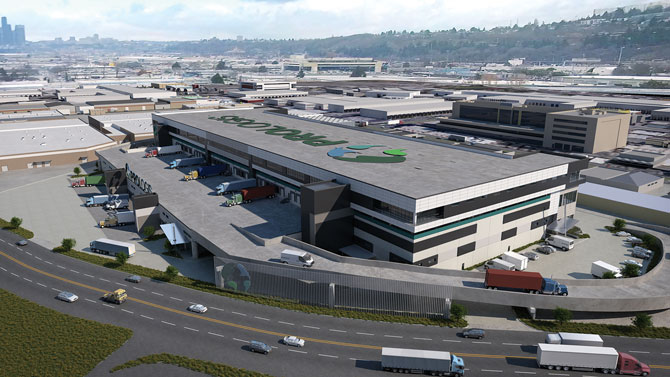
Industrial developers and real estate brokers say Los Angeles County is ripe for 21st century multistory warehouses – where trucks enter on higher floors via ramps for same-day deliveries.
But it might be awhile before markets can support the costs to build the next-gen facilities.
Factors that favor a vertical shift: A vacancy rate of less than 2 percent in the county’s 800 million-square-foot industrial market, which saw an 8 percent year-over-year jump in average rent to 82 cents per square foot last year, according to data from Jones Lang LaSalle Inc.
A key factor getting in the way is the high cost of land in the Los Angeles, where rents would have to right by another 50 percent or so to touch off significant rounds of construction of vertical warehouse space.
“We’re at the tipping point,” said Michael Condon, Jr., an executive managing director at Cushman & Wakefield. “We’ve been close on two sites ourselves.”
One potential deal to build a multistory warehouse near downtown Los Angeles fell through because of costs, Condon added.
“There are a number of developers who have begun the process of looking at it, said Bret Hardy, executive managing director at Newmark Knight Frank.
Multistory warehouses aren’t new – they appear in cities with older buildings and land-cramped areas in Asia and Europe.
The modern versions are built with paved ramps that allow trucks to drive directly to second, third and higher floors to quickly load goods and materials they then deliver to their destinations in densely populated urban areas.
They are still rare in the U.S., but some developers are getting in the game.
Vertical-ready
San Francisco-based Prologis has the first such project in the U.S. under construction in Seattle, a market hemmed in by mountains and Puget Sound, and also happens to host the corporate headquarters of Amazon.com Inc., a main driver of the trend, thanks to its push on delivery services that require more warehouse space in densely populated markets.
The Prologis Georgetown Crossroads project is to be three stories tall and nearly 590,000 square feet. Truck ramps will lead to the second level loading docks, while forklifts will access its third floor by special freight elevators for lighter-scale warehouse operations, according to the company’s website. Prologis did not respond to requests for comment.
The Georgetown Crossroads project, slated for opening later this year, is being closely watched by industry observers to study the viability of the multistory approach to warehouses in the U.S.
Other developers are at work designing multistory warehouses in New York City. Goldman Sachs and developer Dov Hertz plan to build a three-story, 370,000-square-foot warehouse in Brooklyn. And a joint venture of Square Mile Capital Management and Innovo Property Group are planning a two-story, 840,000-square-foot warehouse in the Bronx.
“You might see a lot more of this,” said John Morris, the industrial services lead at Cushman & Wakefield. “This is a movie that’s about to kick off.”
Driving these developments is the relentless success of Amazon and the e-commerce revolution. Wal-Mart Stores Inc. and other major retailers have are increasingly focusing on quick delivery to “last mile” consumers – the space between the distribution center and home.
Another factor behind the building style trend is same-day delivery – a service that was considered a luxury a decade ago and is increasingly a standard expectation among consumers. For AmazonFresh, the grocery subsidiary of the e-commerce giant that gets fresh food to consumers, timing is of the essence.
The two trends have forced e-commerce operations to take larger and larger spaces so they can store goods closer and closer to major population centers, such as Los Angeles and its suburbs.
“People want (goods) within an hour or two hours in some cases,” said Jay Todisco, executive vice president at Ware Malcomb, an Irvine-based developer currently at work on a vertical warehouse project in New York.
Seattle, San Francisco and New York are strategic locations for the multistory warehouses due to their dense populations but are expensive real estate markets with little land for industrial expansion.
Los Angeles fits the same profile.
“(Last-mile distribution) has become important because the rising megacities…have created large density in urban areas,” said Nick Vyas, an assistant professor of clinical data sciences and operations at the USC Marshall School of Business.
Cost prohibitive
The high price of land in Los Angeles is compounded by high prices for materials and labor here.
L.A. County’s average industrial rent in the first quarter was about 85 cents per square foot, a gain of almost 75 percent from the fourth quarter of 2009.
That number needs to rise to more than $1.20 per square foot before the financials begin to make sense, the experts say.
Cities that would make sensible locations for high-rising warehouses, Hardy cited, include Hawthorne, Torrance and El Segundo for their good access to freeways, Los Angeles International Airport and the ports of Los Angeles and Long Beach. Other sites include industrial centers such as Vernon and Commerce, observers said.
Finding enough land where trucks have enough room for their turning radius can be another hurdle.
“The need is in the last mile, but the land availability is not in the last mile,” said Ken Jackson, chief executive at Irvine’s Camfield Partners. “That’s the conflict.”
